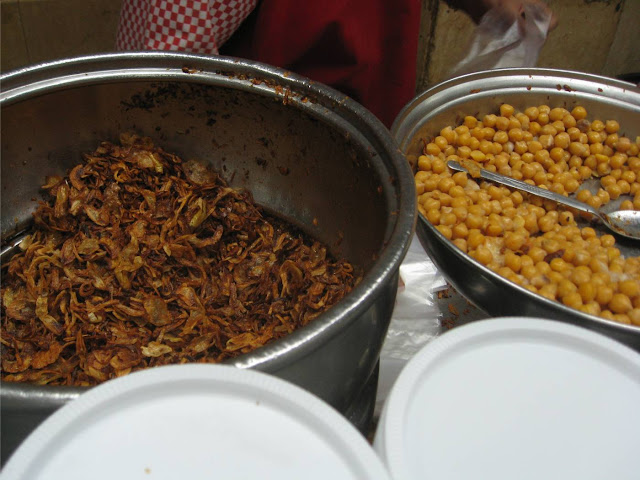The most famous koushary restaurant in all of Egypt is Koushary Abou Tarek, in Cairo. Tarek's father is a success story. He began selling his recipe from a wood street cart years ago and now owns a multistoried establishment near Tahrir Square. He has been famous for his koushary for years but now he is revered for it is said that he fed the January 25th Revolution because his was the only restaurant that remained opened during the strife.
Many Egyptian women will make koushary for their families but the combination of rice, pasta, lentils, chickpeas and tomato sauce is time-consuming to prepare. I often see women carrying bags of koushary home for a late evening meal with their families. A local fellow told me I could find the best koushary in Luxor at Al Zaeem Restaurant in the city's center. Interestingly enough, in Arabic "Al Zaeem" means "The Revolutionary". There definitely seems to be a link between koushary and power to the people.
Al Zaeem has two doors. On the right, stairs lead upstairs, where the décor is glass, marble veneered walls and tabletops and stainless steel plates and utensils. Here customers sit and have their favourite meal delivered to their table. Down at street level, from the wide open 'door' on the left, a constant stream of customers flow in and out with take-away orders.
Stacks of small and medium-sized plastic tubs in a storefront window often identifies a koushary restaurant. Behind the stacks stands the koushary's maestro. Some are very entertaining to watch as they twirl their spoons and play a little tune on the pots and dishes. Abou Ahmed at Al Zaeem is more down-to-earth. His focus is on getting the people their food. A conservative estimate puts the numbers of koushary orders at approximately 20,000 per day.
All ingredients are precooked in the back kitchen and kept warm up front in large open bowls. Do not touch the counter beneath them -- it's hot!
First into the take-away tub is the pasta, a mixture of tubuli and short strands of spaghetti. Next, a big scoop of Egyptian rice is heaped in. Egyptian rice often includes pieces of fried vermicelli. Onto this carbohydrate base goes a good helping of brown lentils coated with seasonings and a ladle of tomato sauce.
Finally, fried onions and chickpeas are sprinkled on top.
Tubs are then sealed and packed with a plastic spoon. Take away orders come with two small plastic bags filled with two important condiments: a spicy chili oil and a tangy garlic vinaigrette.
Upstairs in the seating area, the dish is served with tomato sauce on the side, to be added according to the customer's taste. The size of the condiment vessels stationed at every table conveys the relative proportions of garlic and chili sauces that are typically added. A small pitcher contains the vinaigrette da’ah made of lemon juice, garlic, cumin, vinegar and water; whereas a tiny bowl holds the hot sauce, called shattah, which is a mixture of hot chili pepper and oil.
Caution should be exercised when applying this Egyptian hot sauce. Its glowing crimson colour only hints at its fiery flavour.
Koushary is a hearty meal. A small portion is generally sufficient to appease a normal appetite. A medium portion feeds two people quite nicely, while the large portion feeds a family. All this tasty nourishment comes for between 2LE (small) and 5LE (large). At today's exchange rates, a family can eat for about 85 cents. If they are Egyptian. Unfortunately, the cashier at Al Zaeem enjoys cheating foreigners by charging them double. The cash receipt states the price quoted but the Arabic text shows that he's charged for a chicken meal not koushary. Such is the frustrating reality of shopping in Luxor.
Regardless of the cashier's tricks, the koushary is delicious and it both nourishes the body and soothes the soul. Centuries ago, the fourteenth century scholar Ibn Battuta wrote about koushary in his travel diaries yet some debaters insist that the dish was not made in Egypt until World War II when British troops brought the recipe from India. Whatever its origin, koushary is definitely ‘the food of the people’.
WHERE TO FIND ME
View Larger Map
The red storefront of Al Zaeem Restaurant is almost visible in the bottom right corner of Google's map. If you zoom out, you will see that it is located very close to Luxor Temple.
| GETTING THERE | USEFUL INFO SOURCES |
|---|---|
| Al Zaeem Restaurant is located on Moustafa Kamel Street in downtown Luxor. From the Emilio Hotel, walk approximately 200 m East on Moustafa Kamel Street. The restaurant is on the left-hand side. Its facade cannot be missed. | Serious Eats article: “Koshary: Feeding a Revolution in Cairo” by S. Farhan Mustafa |
| Al Masry Al Youm article: Koshary Confidential | |
| World Vision Report audio news report: "Koshary: The Food that Fed a Revolution" | |
| EgyptianRecipes.Net website: Koshari Recipe | |
| Tour Egypt website: Koshary | |
| Clifford A Wright website: History of Koshary |














1 comment:
An Egyptian friend from Cairo tells me that he is treated as much as a foreigner at Al Zaeem as I am. ;-)
Post a Comment